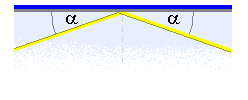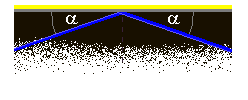Reflection at smooth surfaces


Figure 1: reflection at a mirror
When a wave approaches a reflecting surface, such as a mirror, the wave that strikes the surface is called the incident wave, and the one that bounces back is called the reflected wave. An imaginary line perpendicular to the point at which the incident wave strikes the reflecting surface is called the normal, or the perpendicular. The angle between the incident wave and the normal is called the angle of incidence. The angle between the reflected wave and the normal is called the angle of reflection.
If the surface of the medium contacted by the incident wave is smooth and polished,
each reflected wave will be reflected back at the same angle as the incident wave.
The Law of Reflection states:
The angle of incidence is equal to the angle of reflection.
After reflection takes place, however, the waves are approximately 180 degrees out of phase
from their initial relationship.
